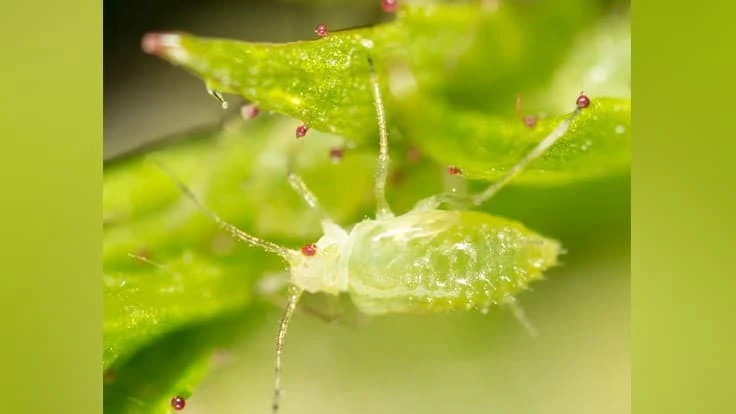

The expression ‘out of sight, out of mind’ dates back to at least 1562, according to one source, but still applies today. Aphid infestations in hanging baskets continue to unpleasantly surprise growers. The rise of vegetative propagation may have something to do with it — aphids aren’t seed-borne as far as anyone’s been able to prove — though other sources of infestation in or around the greenhouse can also be involved. Use of neonicotinoid insecticides, once widely used preventively, is being questioned, and some operations are asking about alternatives — particularly when overhead crops are difficult to treat and receive little attention after hanging. Following are some suggestions for dealing with the situation.
Know your aphids
Aphids are often dismissed as just a single pest — until we discover there are important differences among the species. Biological controls, like parasitoid wasps and some ladybeetles, don’t control them equally well, and have decided preferences for some species over others. Bean aphid, for example, is not very amenable to biological control, while melon and green peach tend to be. Some aphids — or strain of a species – are less susceptible to insecticides than others. Foxglove aphid prefers cooler conditions of early spring or late winter, while melon aphid thrives in heat. Green peach aphid enjoys many greenhouse crops, while the eponymous cabbage and chrysanthemum aphids are much more fastidious. These, and potato aphid, are the main species we encounter. Others I have seen on greenhouse crops over the years include tobacco (which may be a variant of green-peach aphid), cowpea and leaf-curling plum aphids. It isn’t too difficult to distinguish among the five or so most common species with a bit of practice. There are photos online and some helpful print references. Another option is to check with a diagnostic lab if unsure. Identifying aphids informs most pest-management choices and can make a big difference.

Know where they lurk
Aphids (and some other pests) can be on the weeds under benches, suggesting one strategy for management. Stock plants and pet plants are usually suspect, carrying pests and pathogens over from one crop to another or into the greenhouse when brought in for winter. Vegetative cuttings offer another route of introduction. In warmer climates or seasons aphids can migrate in from outdoors. Scout for aphids by scanning new growth for shiny honeydew, white cast skins and the aphids themselves. Aphids can be well-camouflaged. Turn over leaves, tap terminals onto a white surface, look behind flowers, check stems — spend most time on likeliest sources and less on seed-grown crops. Yellow sticky cards will trap flying aphids, but they are not the more reliable way of early detection. However, they are still useful and will trap pests like thrips and whiteflies, so include them in your monitoring plan.

Have a low tolerance Treat before sticking?
It might make sense to treat the crop just before sticking but while still in transplant trays using a product highly effective against aphids — a more conservative way that uses less insecticide. Insecticidal soap or horticultural oil works on contact but will need very thorough coverage. Some plants are sensitive and repeat applications may increase chance of injury. In one trial on poinsettia I found an overhead rinse with clear water within 20 minutes after a 2% M-Pede spray sacrificed little in control but significantly reduced leaf burn. We have not yet tried this on bedding plants. Check with your extension specialists or representatives from different suppliers for foliar application options. Growers using biological control should check on compatibility.
Care after planting
For out-of-sight hanging baskets, some growers will still want to use a preventive systemic treatment, especially for the more troublesome crops. Distribute the drench so that all plants in the pot receive some; don’t apply to a single small spot. I have even drenched on sale-ready infested 10-inch basket calibrachoa with very good results, but found the recommended label drench volume a bit lean, so I chased it with light watering after application to move material into the root zone. While it is more work, I suggest drenching after plugs are well-rooted and able to take up material; if possible, try to schedule hanging after this treatment or find another way to get the job done. Do not use the same material pre-and post-planting and take special care not to overwater (or sub-irrigate) for a week or more, which could leach the active ingredient from the pot. If the aphid control elsewhere in the greenhouse is very good, instead of using more expensive drench, growers may elect for a final foliar spray immediately prior to hanging for some crops. Whichever, I still recommend spot-checks weekly or so after hanging to watch for pests, diseases and cultural issues. Select plants randomly across varieties for inspection, or consciously bias sampling where appropriate. For example, calibrachoa may need more attention than some other crops. The only surprises at sale should be pleasant ones!

Explore the June 2020 Issue
Check out more from this issue and find your next story to read.
Latest from Greenhouse Management
- Anthura acquires Bromelia assets from Corn. Bak in Netherlands
- Top 10 stories for National Poinsettia Day
- Langendoen Mechanical hosts open house to showcase new greenhouse build
- Conor Foy joins EHR's national sales team
- Pantone announces its 2026 Color of the Year
- Syngenta granted federal registration for Trefinti nematicide/fungicide in ornamental market
- A legacy of influence
- HILA 2025 video highlights: John Gaydos of Proven Winners





